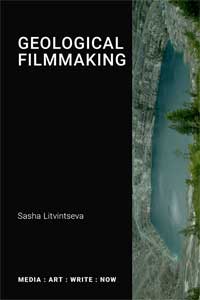Geological Filmmaking
by Sasha Litvintseva

- MEDIA : ART : WRITE : NOW
- Published: 2022
- ISBN: 978-1-78542-110-5
- PDF ISBN: 978-1-78542-109-9
Every film image is geological. As a technical medium derived from the metals and minerals extracted from the earth, every moving image is materially embedded in the world it records. It is also temporally linked to the almost inconceivably vast deep time of the planet’s formation. What would it mean to make films in response to this situation? Geological Filmmaking argues that the challenge lies in situating oneself in the space between the concrete object of a film and the broader planetary conditions of its existence. The nuances of this position are at once formal, ethical and political. Sasha Litvintseva discusses her process of developing such a film practice as a way of tackling the perceptual and aesthetic difficulties presented by ongoing ecological crises. These concerns are explored through the prism of the author’s own films about asbestos and sinkholes in their respective economic and colonial contexts.
Geological Filmmaking develops a new genre of writing rooted in a reciprocity between the practice of making films and the theoretical study of the relations they participate in. Litvintseva expands current conversations in the environmental humanities through building on the rich legacy of experimental film as a tool for producing alternative modes of experiencing the world. The book is intended for readers from a broad range of backgrounds, looking for new ways of dealing with questions about the life and death of our planet.

 Click on the images to access the films, Asbestos (2016) and Salarium (2017), co-directed by Sasha Litvintseva.
Click on the images to access the films, Asbestos (2016) and Salarium (2017), co-directed by Sasha Litvintseva.
Geological Filmmaking is a tour de force of theory and practice. Litvintseva demonstrates with clear and powerful prose that the arts of earthly perception and the aesthetics of political ecological intervention cannot be built with the tools and languages that have caused our climate crisis. Using her own geological filmmaking practice, Litvintseva models the material, including chemical and molecular, kinships between a technical, representational, and aesthetic practice oriented to a post-geontological world.Elizabeth A. Povinelli, Franz Boas Professor of Anthropology & Gender Studies, Columbia UniversityProposing a novel correlation between the filmic and the geological, Sasha Litvintseva’s fascinating Geological Filmmaking delves deep into the film medium’s powers and limitations to grapple with geophysical and environmental phenomena often deemed imperceptible or invisible to the human eye. This is a politically-informed and sharply-written study of film’s entanglements with nonhuman processes, at a time when the current ecological crisis urgently calls for new ways of seeing and sensing the world.Dr Tiago de Luca, Reader in Film Studies, University of WarwickGeological Filmmaking provides a captivating contribution to the ecology of images about ecology, from salt to mud, from minerals to the digital realm. Sasha Litvintseva’s skilful take on the cinema of the invisible but impactful agents of the contaminated world is at ease with so many scales: from the architectural microparticles of ill-health to the geopolitical territories of the ground. Warmly recommended to scholars and practitioners of cinema and beyond!Professor Jussi Parikka, Aarhus University and Winchester School of ArtAuthor Bio
Sasha Litvintseva is an artist, filmmaker, writer and senior lecturer in Film at Queen Mary University of London. Her work is situated at the intersection of media, ecology and the history of science. Her films have been exhibited worldwide, including at the Berlinale and Rotterdam film festivals, Baltic Triennial and Venice Architecture Biennale. She is the author, with Beny Wagner, of All Thoughts Fly: Monster, Taxonomy, Film (Sonic Acts Press, 2021). For more information on her work consult her webpage http://sashalitvintseva.com
